Products Category
- FM Transmitter
- 0-50w 50w-1000w 2kw-10kw 10kw+
- TV Transmitter
- 0-50w 50-1kw 2kw-10kw
- FM Antenna
- TV Antenna
- Antenna Accessory
- Cable Connector Power Splitter Dummy Load
- RF Transistor
- Power Supply
- Audio Equipments
- DTV Front End Equipment
- Link System
- STL system Microwave Link system
- FM Radio
- Power Meter
- Other Products
- Special for Coronavirus
Products Tags
Fmuser Sites
- es.fmuser.net
- it.fmuser.net
- fr.fmuser.net
- de.fmuser.net
- af.fmuser.net ->Afrikaans
- sq.fmuser.net ->Albanian
- ar.fmuser.net ->Arabic
- hy.fmuser.net ->Armenian
- az.fmuser.net ->Azerbaijani
- eu.fmuser.net ->Basque
- be.fmuser.net ->Belarusian
- bg.fmuser.net ->Bulgarian
- ca.fmuser.net ->Catalan
- zh-CN.fmuser.net ->Chinese (Simplified)
- zh-TW.fmuser.net ->Chinese (Traditional)
- hr.fmuser.net ->Croatian
- cs.fmuser.net ->Czech
- da.fmuser.net ->Danish
- nl.fmuser.net ->Dutch
- et.fmuser.net ->Estonian
- tl.fmuser.net ->Filipino
- fi.fmuser.net ->Finnish
- fr.fmuser.net ->French
- gl.fmuser.net ->Galician
- ka.fmuser.net ->Georgian
- de.fmuser.net ->German
- el.fmuser.net ->Greek
- ht.fmuser.net ->Haitian Creole
- iw.fmuser.net ->Hebrew
- hi.fmuser.net ->Hindi
- hu.fmuser.net ->Hungarian
- is.fmuser.net ->Icelandic
- id.fmuser.net ->Indonesian
- ga.fmuser.net ->Irish
- it.fmuser.net ->Italian
- ja.fmuser.net ->Japanese
- ko.fmuser.net ->Korean
- lv.fmuser.net ->Latvian
- lt.fmuser.net ->Lithuanian
- mk.fmuser.net ->Macedonian
- ms.fmuser.net ->Malay
- mt.fmuser.net ->Maltese
- no.fmuser.net ->Norwegian
- fa.fmuser.net ->Persian
- pl.fmuser.net ->Polish
- pt.fmuser.net ->Portuguese
- ro.fmuser.net ->Romanian
- ru.fmuser.net ->Russian
- sr.fmuser.net ->Serbian
- sk.fmuser.net ->Slovak
- sl.fmuser.net ->Slovenian
- es.fmuser.net ->Spanish
- sw.fmuser.net ->Swahili
- sv.fmuser.net ->Swedish
- th.fmuser.net ->Thai
- tr.fmuser.net ->Turkish
- uk.fmuser.net ->Ukrainian
- ur.fmuser.net ->Urdu
- vi.fmuser.net ->Vietnamese
- cy.fmuser.net ->Welsh
- yi.fmuser.net ->Yiddish
What is Varistor : Working Principle, Construction and Its Applications
Date:2021/10/18 21:55:58 Hits:
A resistor is an electric component that is used to limit the flow of current in an electric circuit. It is basically a resistive component. It has two terminals and is used in almost all electric circuits. It can also be sued to adjust signal levels and terminate transmission lines. There are different types of resistors available each meant for a specific purpose. A varistor is one such type of resistor, used to change the resistance in the circuit by changing the voltage. Its design is almost similar to that of a capacitor. These are generally of two types which are metal oxide and silicon carbide.What is Varistor?A varistor is a type of resistor in which we can alter the resistance by altering the applied voltage. It is also called a voltage-dependent resistor. It is a nonlinear semiconductor device. The word is derived from the words variable resistor. These are generally used as safety devices to prevent excess transient voltage in the circuit so that the components of the circuits remain protected. It even controls the operating conditions of the circuit. The design of this component is just the same as that of a normal capacitor. The IEEE symbol of this is shown below. IEEE-symbolThe ICE symbol of this is shown below.
IEEE-symbolThe ICE symbol of this is shown below. 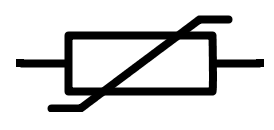 ice-symbolVaristor Working PrincipleA varistor does not obey Ohm’s law and hence it is not like an ohmic resistor. It is basically a non-ohmic resistor that does not follow Ohm’s law and hence it is also called a non-linear resistor or a voltage-dependent resistor. The basic difference between a normal resistor and a voltage-dependent resistor is that would the resistance of a resistor can be altered only by manual action but we can alter the resistance by altering the voltage. The working principle of this is similar to that of a PN junction diode during reverse bias operation.Construction of VaristorThese are mainly of two types: metal oxide and silicon carbide. The metallic oxide type is the most common type of varistor. This device consists of a matrix of a metal oxide containing a ceramic mass of zinc oxide. Some of the commonly used metals are bismuth, cobalt, and manganese.
ice-symbolVaristor Working PrincipleA varistor does not obey Ohm’s law and hence it is not like an ohmic resistor. It is basically a non-ohmic resistor that does not follow Ohm’s law and hence it is also called a non-linear resistor or a voltage-dependent resistor. The basic difference between a normal resistor and a voltage-dependent resistor is that would the resistance of a resistor can be altered only by manual action but we can alter the resistance by altering the voltage. The working principle of this is similar to that of a PN junction diode during reverse bias operation.Construction of VaristorThese are mainly of two types: metal oxide and silicon carbide. The metallic oxide type is the most common type of varistor. This device consists of a matrix of a metal oxide containing a ceramic mass of zinc oxide. Some of the commonly used metals are bismuth, cobalt, and manganese.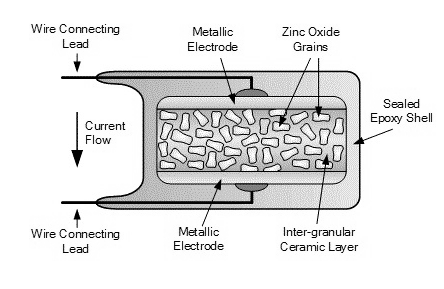 varistor-construction The metal oxide layer basically contains 90% of zinc oxide and 10% of other metals. The metal oxide layer is sandwiched between two metal electrodes. The matrix acts as a binding agent so that the zinc oxide granules can be kept intact between the two metal electrodes. The boundary surface behaves like a junction of a semiconductor diode.Varistor Working and CharacteristicsIn a normal situation, this does not conduct any current. But when the applied voltage crosses the reverse breakdown voltage, the diode starts to conduct electric current.Under normal conditions, a barrister has a very high voltage. However, when the transient voltage in the circuit starts to increase, then the resistance of this will start to decrease so that the transient voltage remains fixed at a certain level.The Resistance of a VaristorThe working of a varistor can be explained using the resistance graph. It is a graph drawn between the resistance of the resistor and the applied voltage. The graph indicates that during normal conditions, the resistance is very high. However, if the applied voltage exceeds the rated value of the resistor, then the resistance of this will start to decrease.
varistor-construction The metal oxide layer basically contains 90% of zinc oxide and 10% of other metals. The metal oxide layer is sandwiched between two metal electrodes. The matrix acts as a binding agent so that the zinc oxide granules can be kept intact between the two metal electrodes. The boundary surface behaves like a junction of a semiconductor diode.Varistor Working and CharacteristicsIn a normal situation, this does not conduct any current. But when the applied voltage crosses the reverse breakdown voltage, the diode starts to conduct electric current.Under normal conditions, a barrister has a very high voltage. However, when the transient voltage in the circuit starts to increase, then the resistance of this will start to decrease so that the transient voltage remains fixed at a certain level.The Resistance of a VaristorThe working of a varistor can be explained using the resistance graph. It is a graph drawn between the resistance of the resistor and the applied voltage. The graph indicates that during normal conditions, the resistance is very high. However, if the applied voltage exceeds the rated value of the resistor, then the resistance of this will start to decrease.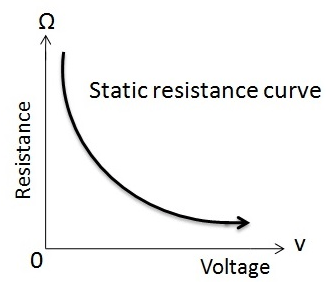 resistance-of-varistor The V-I CharacteristicsFrom the V-I characteristics graph, we can see that even a small change in the amount of applied voltage can lead to a huge change in the amount of current in the circuit. In the V-I characteristics graph, we can see that the varistor acts as if two Zener diodes have been connected back to back. The voltage level at which the current starts to flow is 1mA.During this state, the varistor changes from an insulator to a conductor. This occurs because of the fact that the applied voltage becomes greater than or equal to the rated voltage of the device. This leads to the Avalanche effect of the semiconductor material thus turning a varistor from an insulator to a conductor.
resistance-of-varistor The V-I CharacteristicsFrom the V-I characteristics graph, we can see that even a small change in the amount of applied voltage can lead to a huge change in the amount of current in the circuit. In the V-I characteristics graph, we can see that the varistor acts as if two Zener diodes have been connected back to back. The voltage level at which the current starts to flow is 1mA.During this state, the varistor changes from an insulator to a conductor. This occurs because of the fact that the applied voltage becomes greater than or equal to the rated voltage of the device. This leads to the Avalanche effect of the semiconductor material thus turning a varistor from an insulator to a conductor.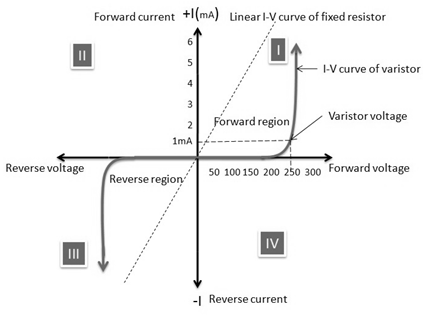 v-i-characteristicsApplications of a VaristorThe applications are1). These can be used to protect electrical circuits from excessively high voltage. The following circuit shows how a metal oxide type can be connected to a circuit to protect it from high voltage.
v-i-characteristicsApplications of a VaristorThe applications are1). These can be used to protect electrical circuits from excessively high voltage. The following circuit shows how a metal oxide type can be connected to a circuit to protect it from high voltage.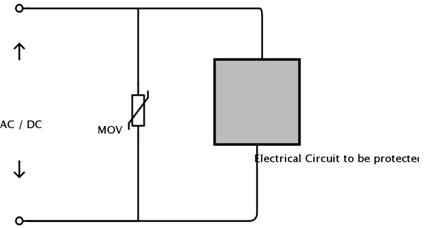 metal-oxide2). The devices connected in an electronic circuit are extremely sensitive to change in voltage. So we use this component in the circuit to protect the different components of the electric circuit. Here, we can see how this can be used to protect a transistor in the circuit.
metal-oxide2). The devices connected in an electronic circuit are extremely sensitive to change in voltage. So we use this component in the circuit to protect the different components of the electric circuit. Here, we can see how this can be used to protect a transistor in the circuit.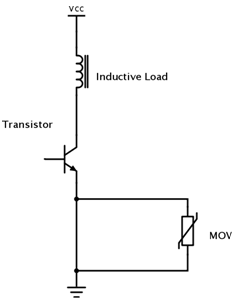 varistor-to-protect-transistor3). It can also be used to provide surge protection in AC and DC motors.
varistor-to-protect-transistor3). It can also be used to provide surge protection in AC and DC motors.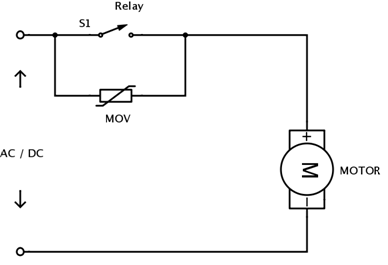 varistor-in-ac-dc-motorsAdvantagesThe advantages of Varistors areIt can be used to protect the electric components of an electric circuit.It provides surge protection to the AC and DC motors.DisadvantagesThe disadvantages of Varistors areIt cannot provide protection from current during a short circuit.It cannot provide protection from current surges during the startup of the device.It cannot provide protection from voltage sags.FAQs1). Does a varistor have polarity?In the case of metal oxide varistor, a zinc-oxide layer is basically sandwiched between two metal electrodes. As a result, there is no polarity.2). What happens when a varistor fails?This may fail due to two reasons: degradation and catastrophic failure. Catastrophic failure mainly occurs when we do not limit a large surge and the magnitude of the energy is higher than the value which the capacitor can handle. As a result of a failure, non-uniform joule heating may occur in the circuit.3). What is the varistor voltage?The voltage generated across the terminals of a varistor when a current of 1mA is allowed to pass through it is called varistor voltage. It is basically the voltage rating.4). How do you test a metal oxide varistor?A metal-oxide type can be tested using a multimeter. One probe of this should touche the free varistor lead and the other probe should touch the connected lead.5). What is the difference between varistor and thermistor?A varistor is an electric element that has a variable resistance and which can protect an electric circuit against power surges. A thermistor, on the other hand, is a resistor whose resistance varies according to the change in temperature.Thus, this is all about an overview of varistor that can serve as a very important device in an electric circuit. Its main use is that it can be used in the protection of electric circuits. It has various other uses as well. How do you think a varistor can be used in real-life projects?
varistor-in-ac-dc-motorsAdvantagesThe advantages of Varistors areIt can be used to protect the electric components of an electric circuit.It provides surge protection to the AC and DC motors.DisadvantagesThe disadvantages of Varistors areIt cannot provide protection from current during a short circuit.It cannot provide protection from current surges during the startup of the device.It cannot provide protection from voltage sags.FAQs1). Does a varistor have polarity?In the case of metal oxide varistor, a zinc-oxide layer is basically sandwiched between two metal electrodes. As a result, there is no polarity.2). What happens when a varistor fails?This may fail due to two reasons: degradation and catastrophic failure. Catastrophic failure mainly occurs when we do not limit a large surge and the magnitude of the energy is higher than the value which the capacitor can handle. As a result of a failure, non-uniform joule heating may occur in the circuit.3). What is the varistor voltage?The voltage generated across the terminals of a varistor when a current of 1mA is allowed to pass through it is called varistor voltage. It is basically the voltage rating.4). How do you test a metal oxide varistor?A metal-oxide type can be tested using a multimeter. One probe of this should touche the free varistor lead and the other probe should touch the connected lead.5). What is the difference between varistor and thermistor?A varistor is an electric element that has a variable resistance and which can protect an electric circuit against power surges. A thermistor, on the other hand, is a resistor whose resistance varies according to the change in temperature.Thus, this is all about an overview of varistor that can serve as a very important device in an electric circuit. Its main use is that it can be used in the protection of electric circuits. It has various other uses as well. How do you think a varistor can be used in real-life projects?
Leave a message
Message List
Comments Loading...

